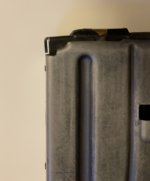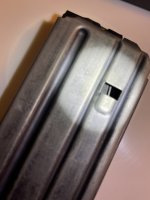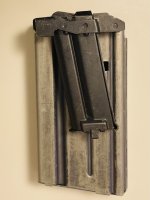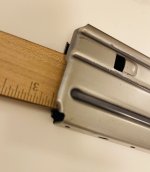Because of frequent misfeeds using the Compass Lake 22LR inserts in 20 round Colt straight AR15 magazines with a Compass Lake 22 upper conversion and a Compass Lake lower, I came up with the following solution after trying a number of different brands of magazines and even removing the follower. The insert seemed to be under undue pressure and was rigidly held in position in the magazine. It did not appear to be adjusting itself to the internal configuration of the receiver and forward path of the receiver/bolt assembly. I considered that this “locked down” position was not allowing a smooth pickup and forward carry into the chamber.
I decided to reduce the AR15 spring tension. I loosened the bottom plate and let part of the spring extend out the bottom of the mag while held in place by the partially inserted bottom plate. At about 10 or 12 “legs” of spring trapped in the magazine, the magazine started feeding with noticeably fewer miss feeds. With 6 and 8 “legs” of spring there were no misfeeds. Four spring legs was too short and the follower was too unstable even with the 22 insert in place. I measured tension on the 22 insert in place with a Warner gauge. It was 34 ounces with 6 legs of spring. I cut the spring to this length. (See picture) Thus far there have been no misfeeds in 400 rounds.
Because the insert is fairly loose, I have to brace it with my index finger (See picture showing finger position) as I load the last 5 or so rounds of the 10 it holds. I also make sure the load insert is positioned so it moves freely when I press straight down with 34 ounces of pressure with my finger. (See picture of this press and picture showing position of loaded cartridge)
I know that there are other solutions to the misfeed problem with M261 inserts and that the reasons I had with misfeeds are not the same for everyone. This is just another solution to try. Please give feedback if you use this and cover any modifications and improvements and even what didn’t work. I would welcome other ideas about what accounts for the misfeed problem.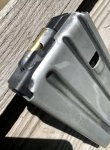
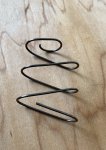

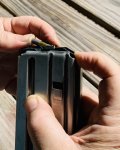
I decided to reduce the AR15 spring tension. I loosened the bottom plate and let part of the spring extend out the bottom of the mag while held in place by the partially inserted bottom plate. At about 10 or 12 “legs” of spring trapped in the magazine, the magazine started feeding with noticeably fewer miss feeds. With 6 and 8 “legs” of spring there were no misfeeds. Four spring legs was too short and the follower was too unstable even with the 22 insert in place. I measured tension on the 22 insert in place with a Warner gauge. It was 34 ounces with 6 legs of spring. I cut the spring to this length. (See picture) Thus far there have been no misfeeds in 400 rounds.
Because the insert is fairly loose, I have to brace it with my index finger (See picture showing finger position) as I load the last 5 or so rounds of the 10 it holds. I also make sure the load insert is positioned so it moves freely when I press straight down with 34 ounces of pressure with my finger. (See picture of this press and picture showing position of loaded cartridge)
I know that there are other solutions to the misfeed problem with M261 inserts and that the reasons I had with misfeeds are not the same for everyone. This is just another solution to try. Please give feedback if you use this and cover any modifications and improvements and even what didn’t work. I would welcome other ideas about what accounts for the misfeed problem.





